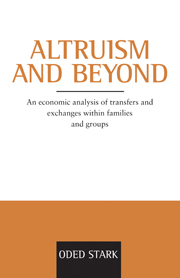Book contents
- Frontmatter
- Contents
- Preface
- Introduction
- 1 Altruism, transfers, and wellbeing
- 2 The timing of intergenerational transfers: an implication
- 3 An exchange implication of transfers: the demonstration effect
- 4 Transfers by migrants: a strategic motive for remittances
- 5 Exchange with recognition costs: an explanation of migrants' performance
- 6 Intrafamilial transfers and exchanges: forming and sustaining altruism
- Index
4 - Transfers by migrants: a strategic motive for remittances
Published online by Cambridge University Press: 23 September 2009
- Frontmatter
- Contents
- Preface
- Introduction
- 1 Altruism, transfers, and wellbeing
- 2 The timing of intergenerational transfers: an implication
- 3 An exchange implication of transfers: the demonstration effect
- 4 Transfers by migrants: a strategic motive for remittances
- 5 Exchange with recognition costs: an explanation of migrants' performance
- 6 Intrafamilial transfers and exchanges: forming and sustaining altruism
- Index
Summary
Introduction
The modeling of migrants' remittance behavior is of interest for four distinct reasons.
First, remittances are of a gigantic magnitude. Two examples serve to illustrate this. In 1980 workers' remittances provided as much foreign exchange as exports did for Pakistan and Upper Volta, more than 60 percent of exports for Egypt, Turkey, and Portugal, and about 40 percent of exports for Bangladesh and Yugoslavia (World Bank [1984]). The International Monetary Fund estimates that in 1990, remittances into 38 labor-exporting countries amounted to US$33.8 billion (Elbadawi and Rocha [1992]). This must, however, be a lower bound because remittances through “unofficial” channels are not included in this estimate. There are many more rural-to-urban migrants in developing countries than there are international migrants from developing countries in more developed countries, and as a general rule, internal migrants frequently tend to remit to their families back in the rural areas about 30 percent of their urban-earned income (Stark [1991]). Even though the absolute sums remitted by internal migrants are considerably smaller than the sums transferred by international migrants, the considerably larger number of internal migrants implies total internal remittances running into billions of dollars.
Second, predicting remittance response to perturbations either in the incomes of recipients of remittances or in the incomes of remitters is sensitive to the motive for remitting. Policy choice is likewise sensitive. To illustrate, consider altruism versus exchange. The altruistic hypothesis of remittances predicts that remittances received and recipients' pre-transfer income would be inversely related. In other words, altruistic migrants react to recipients' income shortfalls by remitting more.
- Type
- Chapter
- Information
- Altruism and BeyondAn Economic Analysis of Transfers and Exchanges within Families and Groups, pp. 89 - 108Publisher: Cambridge University PressPrint publication year: 1995

